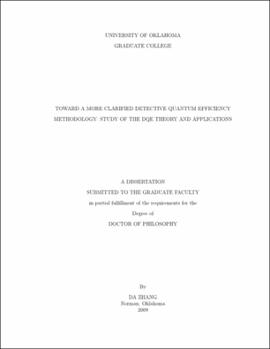| dc.contributor.advisor | Liu, Hong | |
| dc.creator | Zhang, Da | |
| dc.date.accessioned | 2019-04-27T21:28:45Z | |
| dc.date.available | 2019-04-27T21:28:45Z | |
| dc.date.issued | 2009 | |
| dc.identifier | 99224160002042 | |
| dc.identifier.uri | https://hdl.handle.net/11244/318786 | |
| dc.description.abstract | Detective quantum efficiency (DQE) is widely accepted as the golden rule to objectively evaluate the performance of x-ray imaging systems. It provides a comprehensive characterization of an x-ray imaging system, because it combines several important image-quality-related measurements such as contrast, resolution, and noise, and because it measures the efficiency of the utilization of x-ray in the imaging process. Despite its importance, the current DQE methodology is imperfect in general agreement. The focus of this dissertation is to investigate the DQE methodology for digital x-ray imaging systems, in an effort to clarify some confusing aspects of the current DQE methodology. Through a detailed theoretical derivation of the DQE methodology for digital x-ray imaging, a more clarified understanding of the DQE theory is provided. Besides the re-visited DQE theory, techniques to determine the constituent parts of DQE, including the photon fluence, Modulation Transfer Function (MTF), and Noise Power Spectrum (NPS) are also discussed in this dissertation. | |
| dc.description.abstract | The dissertation is structured as follows. After a brief introduction of the current DQE theory in Chapter 1, the DQE theory for digital x-ray imaging systems is revisited in detail in Chapter 2, with experimental results for the demonstration purpose. In Chapter 3, DQE theory for the magnification radiography is provided, and the theory is supported by experimental results. In Chapter 4, the measurements of x-ray photon fluence and spectral composition are discussed in detail, and uncertainty analysis is conducted to investigate the impact of the calibration uncertainty on the two measurements. In Chapter 5, an innovative alignment procedure that was designed to reduce the error in the spectral measurements and imaging experiments is introduced. MTF measurement techniques are covered in Chapter 6, and NPS measurement techniques are discussed in Chapter 7. As an example application of the DQE methodology, a study about the impact of additive noise on the imaging performance of a CCD based x-ray system is also reported in Chapter 7. In Chapter 8, a DQE analysis on an innovative dual detector x-ray imaging system is detailed, as another example application of DQE. Finally, a summary of this dissertation is provided in Chapter 9. | |
| dc.format.extent | 181 pages | |
| dc.format.medium | application.pdf | |
| dc.language | en_US | |
| dc.relation.requires | Adobe Acrobat Reader | |
| dc.subject | Imaging systems in medicine | |
| dc.subject | X-rays | |
| dc.subject | Radiography, Medical--Digital techniques | |
| dc.title | TOWARD A MORE CLARIFIED DETECTIVE QUANTUM EFFICIENCY METHODOLOGY: STUDY OF THE DQE THEORY AND APPLICATIONS | |
| dc.type | text | |
| dc.type | document | |
| dc.thesis.degree | Ph.D. | |
| ou.group | College of Engineering::School of Electrical and Computer Engineering | |
